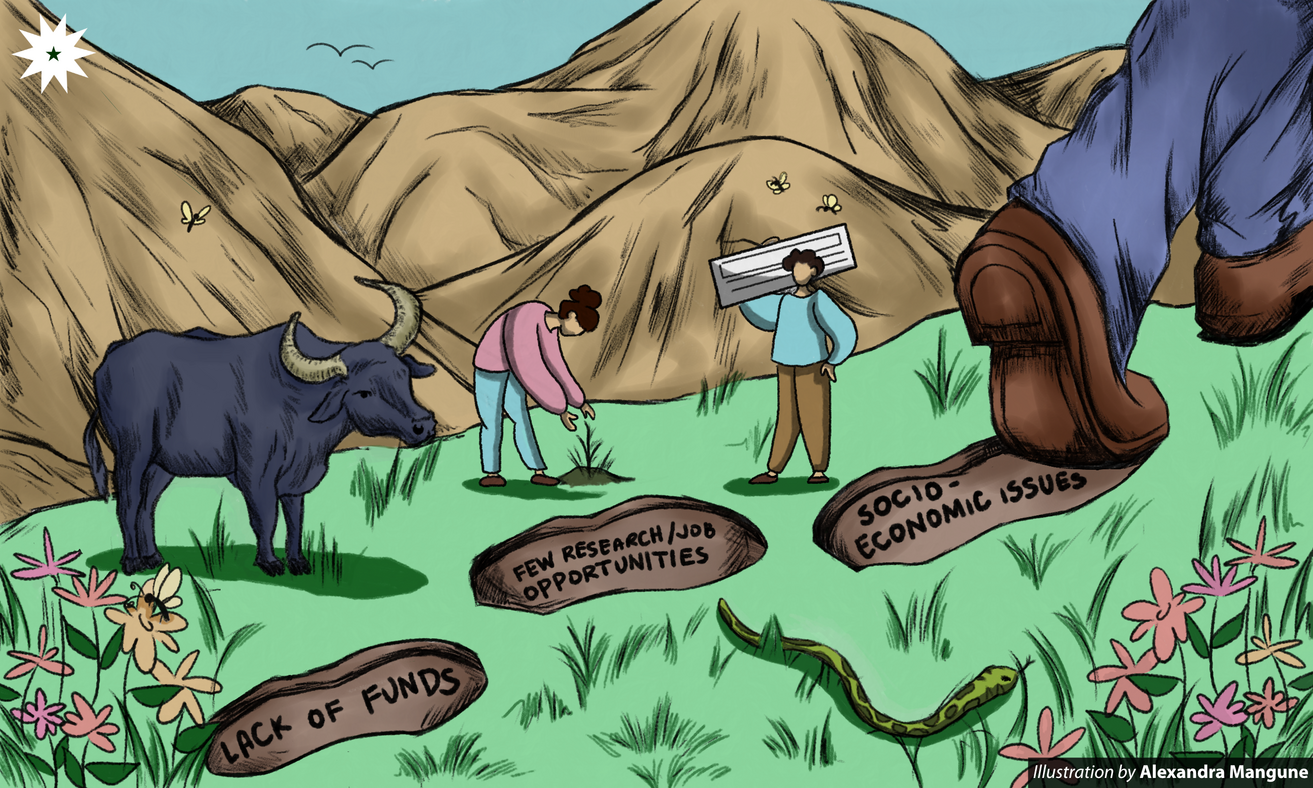
When people think of nature, images of various flora and fauna interacting and thriving in their habitat come to mind—untouched by the ravages of time. Rarely do people include the human species in this mental picture. As nature is often associated with concepts free from human influence, a line is drawn between humanity and nature. This idea of Mother Nature being a self-sustaining and self-correcting entity can often breed ignorance and apathy toward the continuing decline of the environment.
That is where youth wildlife conservationists break through, ensuring that people uphold their responsibilities and duties as stewards of the environment. However, with the added pressure of the ongoing pandemic and the public’s unfamiliarity with the field of wildlife studies, conservation efforts here in the Philippines have only increased in complexity—adding to a growing list of challenges wildlife conservationists face today.
Bridge between worlds
One must understand that a wildlife conservationist can hail from a diverse set of jobs. As Arianna Norton, an environmental researcher and the co-project head of For The Future Philippines, explains, “Anyone can be a conservationist even without concrete career paths. It’s about listening to all sides of the conversation, seeing the gap in which positive changes are needed, and taking action toward making the changes.” Her organization, For The Future Philippines, is a team of 12 individuals of varying professional backgrounds vying for a better and greener tomorrow.
Despite the Philippines being lauded as one of the 18 megadiverse countries in the world, professions such as Norton’s remain largely unknown to the public, especially for employers. Kier Mitchel Pitogo, a wildlife biologist currently working for the Department of Environment and Natural Resources (DENR), acknowledges this, saying, “Only a few people delve into the areas of wildlife biology, ecology, and related fields.”
Such obstacles only further complicate the position of individuals such as Norton and Pitogo. However, in recent years, institutions like the DENR and other wildlife-centric non-governmental organizations (NGOs) have made strides in providing job opportunities for individuals interested in the field. They’ve also been publishing information regarding environmental issues, like the list of threatened species in the country, as a means to spark public interest because, as Norton explains, “Being educated and informed is the fundamental step to taking action.”
Crisis for conservationists
Hardly spared from the impact of the pandemic, wildlife protection organizations like the Philippine Eagle Center and Philippine Reefs and Rainforests Conservation Foundation, Inc. have had to suffer from limited funding since visitors are no longer allowed in their conservation sites. Norton explains, “This lack of monetary inflow meant that they wouldn’t be able to feed their animals and even pay their caretakers that work tirelessly day after day.” The past year imposed a terrible crisis on human health and welfare, but increasingly so for conservation efforts of Philippine wildlife.
In addition, with the persistent challenges faced by our endemic fauna and flora, Norton worries, “How do we get people, who are now stuck at home, to even begin to [care] about animals they’ve never had any connection to?”
The inadequate support for conservation efforts is also reflected in the fieldwork. A lot of biodiversity areas, such as the Busa Mountain Range, remain estranged and short of empirical data to support proper conservation interventions. Pitogo explains that their work requires them to spend weeks or even months in mountains and other far-flung places, which can be a danger in itself. He recalls an uncomfortable experience with the Armed Forces of the Philippines once while seeking permission for fieldwork. “My study site is identified as a ‘red area’ as what they call it. And as a student of [UP] Los Baños at the time, I inevitably experienced red-tagging.”
As a wildlife biologist, Pitogo had to defend the importance and integrity of his work. The Philippines has been named by the Kalikasan People’s Network for the Environment, a local NGO, as one of the most dangerous places for environmental defenders. The death of botanist Leonard Co back in 2010, wherein soldiers shot him and two of his colleagues while they were doing fieldwork, remains unresolved to this day. “Red-tagging is a serious concern,” Pitogo remarks, “People should understand that it is normal for us to go into the forests and stay long to do science or be in the streets to advocate for environmental integrity and justice.”
Further along the trail
Wildlife conservation is not an isolated concern—it is burdened with intersectional ties to socio-economic issues. Pitogo acknowledges how threats to biodiversity such as overexploitation and wildlife trade can be traced to societal problems. He points out how big of a piece wildlife plays in current problems. “If we learn to see the link, it helps us to critically think and start grasping complex issues, such as environmental justice.”
Understanding the elaborate responsibility of nurturing wildlife puts global health into perspective. Norton points out that food security, waste management, urban planning, and forestry are all vital aspects for sustaining life in the long run.
As Pitogo describes it, the problems surrounding wildlife conservation are complex and intertwining, and Norton agrees, saying, “It can be incredibly overwhelming doing a deep dive into environmental issues and seeing that there is so much that needs to be done. But that also makes us trailblazers.” The work of wildlife conservationists entails an unending pursuit of knowledge about ecosystems and how to preserve them, amid the challenges of a modernizing society.
Through the years, the concern for biodiversity, wildlife conservation, and more environmental issues have increasingly captured the hearts and ears of those who are willing to help. “[The] answer was to simply start a conversation about them. Build a connection [with the people],” Norton states. The youth especially have been amplifying the platform for the environment. “Our ingenuity and grit make us good communicators of science,” Pitogo notes, “We need youngbloods in the sciences to continue understanding our rich and unique biodiversity for its continued existence.”
